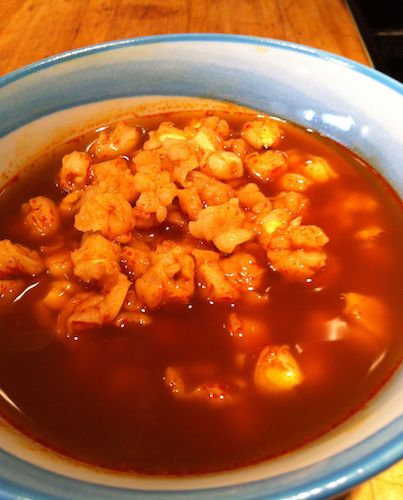Pozole, Posole: Corn Flowerettes Make A Vegan Feast

This pozole, posole, is a vegan delicacy and one of my favorite dishes to serve at dinner parties. Most recipes make pozole with pork, but this is more traditional, because pork arrived in Mexico only about 500 years ago, so before that, we were pork-less and loving it.
In every variation of pozole, large corn kernels (Cacahuazintle) pop open to form small little flowers. Brilliant the cook that invented this attractive dish. Cooked with special combinations of red chiles it is a traditional dish that is also cooked by native communities northwest of us, Pueblos in New Mexico and Navajos in Arizona (Keegan, 2010).
It is traditional from our Texas Mexican region all the way down to Jalisco, Mexico and beyond. It is spelled with an S in Texas, Northeastern Mexico, Arizona and New Mexico and with a Z in central and southern Mexico. In this version, and in most of my posole versions, I omit the pork, harking back to pre-colonial traditions and making this a vegan feast recalling the pre-pork days of our cuisine.

The process is molecular. Boil large white, dry corn, called maíz pozolero, with calcium hydroxide (slaked lime). It’s a process called nixtamalization and it was invented by indigenous Mexican women about 3,500 years ago. Nixtamalization is from the Nahuatl root words, “nextli,” ashes and “tamallii,” tamal. Burnt wood ash (potassium hydroxide) was the chemical used in nixtamalization. The process changes the chemical structure of the kernel, making niacin available in digestion and boosting the availability of protein.

It also removes the skin from the kernel and improves the taste. This is natural molecular cooking and the result is wonderfully nutty hominy.
If you don’t have the time for nixtamalization, you can certainly use canned hominy, maiz pozolero.
Recipe: (Serves 8-12)
Ingredients
For the corn
1 ½ lbs Cacahuazintle, dried white corn for pozole. In Houston I buy this large white dried corn from any of our corn mills that perform nixtamalization to make tortillas and masa for tamales.
1 Tbs Calcium Hydroxide (slaked lime)
For the chile paste:
3 Guajillo Chiles, deseeded and deveined
2 Chiles Ancho
3 Garlic cloves
1 Tbs dry Mexican Oregano
1 tsp Cumin seeds
5 Garlic cloves
1 Tbs Salt
1 White onion, peeled and cut into quarters
Accompaniments:
½ Cabbage, sliced into thin strips (I sometimes use shredded Iceberg lettuce)
1 bunch Radishes, thinly sliced
1 cup White Onion, small dice
3 Mexican limes, cut into wedges
1 bunch fresh Cilantro, coarsely chopped
Method:
The corn:
1. The night before, place the dry corn in a large pot and fill with water 4 inches above the corn. Soak overnight.

2. The following day, discard the water, then add clean water and the calcium hydroxide, “cal.” Bring the water to a boil and boil the corn for 15 minutes. Check doneness by taking out one kernel and rubbing between your thumb and forefinger. If the outer, slippery skin rubs off easily, the corn is done. Let the corn soak in the water for 10 minutes, then drain.
3. Place the corn in a bowl or pot of clean water and vigorously rub the kernels together to scrape away the slippery skin from all the kernels. Change the water as needed until you get no debris and the corn is clean and white. This is labor intensive. Some of the little brown seed germs on the kernel tips will fall off. That’s very good, because they have to be removed.
4. Use your fingernails or a knife or scissors to take off the little brown seed germ, pedicel, at the tip of each kernel. Although it’s not traditional, you can leave the pedicel on if you like. Set aside.
The Chile paste:
5. Remove the seeds from the chiles by cutting a slit lengthwise in each chile to open it and remove the stem with the attached seeds. Remove all the other seeds in the chile pod.
6. Place the chiles in a large pot and cover them with water. Bring to a boil, turn off the heat and let the chiles steep for 15 minutes so they will re-hydrate. Drain and allow to cool. Discard the water.
7. Place the chiles, garlic, oregano and cumin in a blender. Add one cup of clean water and blend on high until the paste is completely smooth, with no large particles. It is ok to add a little more water if needed. If there are large particles in the paste after you are done blending, strain the paste through a fine mesh sieve.
Boil the posole (pozole)
8. Add the chile paste, garlic cloves and onion to the cleaned corn, adding enough water to cover three inches above the corn, and boil it for one hour or longer until the kernels burst open like little flower buds. If you have kids, they’ll love this transformation.
Serve the pozole in bowls accompanied by finely shredded cabbage, thinly sliced radishes, lime wedges, Cilantro and diced white onion. Of course, steaming corn tortillas.

REFERENCES:
Keegan, M. (2010). Southwest indian cookbook. Santa Fe: Clear Light Publishing.